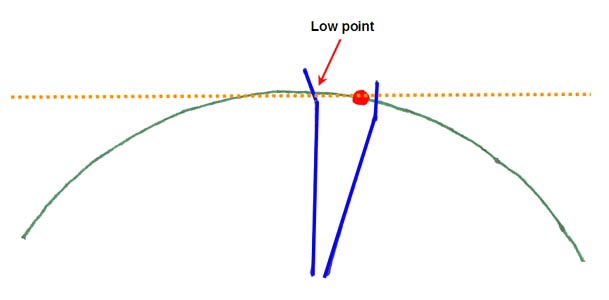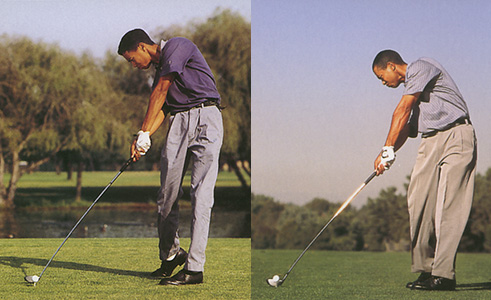What Is Pivot?
Simply put, pivot is the rotation back and thru of the hips, core, torso and shoulders. There's some talk of the knees and other parts of the body 'pivoting', but they really do not turn.
Why Is Pivot Important?
The key to powerful, accurate and consistent shots starts with a flat left wrist at impact. The history of the game has seen great golfers using all sorts of grips, address positions, swing planes, etc. Many of these have been considered unorthodox and even flawed.
Moe Norman stood a mile away from the ball with his clubhead a good foot behind the ball at address. Woody Austin stands extremely close to the ball. Hogan was considered to have a very weak grip and Paul Azinger played with an extremely strong grip. Trevino, Couples and Furyk all looped the club out to in. Guys like Hogan and Stewart Cink had very flat golf swings. Nicklaus was knocked for a flying right elbow. Miller Barber had a big time flying right elbow.
All different grips, swing planes, address positions, and some very big 'flaws.' All hit the ball great. Why? Essentially they all had a flat left wrist at impact. Not a single tour pro, even the Kenny Perry's and Eamonn Darcy's of the world had a bent left wrist at impact.
But having a flat left wrist at impact is easier said than done. And where most people screw up is that you need a GOOD pivot to have a flat left wrist at impact. In fact, every golfer who has played on the PGA Tour for any amount of time has had a good pivot. And it's no coincidence that the all time greats usually had phenomenal pivots.
Here's a pic showing the path of the clubhead in relation to the target line:

As you probably know already, the correct path of a clubhead in the golf swing (as shown above) has the clubhead going inside on the backswing and then coming at the ball from the inside on the downswing. Then it makes contact with the ball and eventually comes back to the inside on the follow through. It essentially makes an arc as shown by the green arc in the picture above.
Because of this natural arc as shown in the picture, this FORCES the pivot to be important.
A good rule of thumb is to have a pivot such that the hips have rotated enough so the zipper is about facing the target at impact.

However, most amateurs, particularly the high handicapper have only rotated the hips so they are square at impact.
So here's what I want you to do.
Grab a club.
With your hips square to the target try to follow thru with the clubhead going to the inside of the target line.
For the most part, the only way to do that is to 'flip thru' and bend that left wrist. Now, you could keep the left wrist flat, but it would be very uncomfortable and would consist of a huge chickenwing of the left arm. Not very natural and doesn't happen.
Now, grab the club again and get the zipper pointing near the target. Next, try to follow thru with the club head going to the inside like it's supposed to. You should notice that now you 'have room' to bring that clubhead naturally to the inside without bending the left wrist.
Also, go out to your golf course and watch some bad hackers chip and watch some good players chip. The hackers will chip with a SQUARE STANCE and inevitably flip their wrists thru impact. The low handicappers will chip with an OPEN STANCE and keep that left wrist flat at impact.
The reason being is that the chip shot swing is a short swing. We don't really have enough time to pivot in a chip shot swing (and YES, you HAVE TO pivot a little bit in a chip shot). So what the low handicapper is doing is opening his stance as a way to 'pre-pivot' at address. So at impact that zipper is facing near the target and the hands have enough room to return the club to the inside on the follow thru while having a flat left wrist. The high handicapper starts off with a square stance and has no time to pivot in the chip swing and thus that flips those hands thru impact.
So that's why the pivot is so important. It's really the only way a golfer can keep that flat left wrist at impact. The pivot also generates more clubhead speed than somebody who is swinging the club without any pivot whatsoever.
What is a good pivot?
I believe the most important part of the pivot is the thru pivot (aka the pivot in the downswing) because you hit the ball with your downswing and if you can master that, you're pretty well off. Here's a video of essentially what should be going on in the thru pivot.
Now, Manzella puts the club inside his left hip which is just fine. However, I feel that a good rule of thumb is keeping the hands behind where the zipper is POINTING. It's also very important, as Manzella notes, that hands don't pass that point until about the halfway point of the follow thru.
You will often hear instructors talk about golfers 'quitting' or 'stalling' their pivot and that causing the flip. What often happens is that they do keep the hands behind where the zipper is pointing at impact, but right after impact the hips stop pivoting just a tad and the hands get past where the zipper is pointing before the halfway point of the follow through.
However, as important as the thru pivot is, the backswing pivot is important because it usually puts the golfer in position to have an effective thru pivot and get that zipper out in front of the hands. Again, I use the word usually as I've seen some golfers with so-so backswing pivots and then have tremendous thru pivots.
As I typed earlier, the history of golf has seen great golfers with all sorts of different swings. And while all of the great golfers have had great pivots, there's more than one way to pivot. So there's not one correct way to pivot.
Types of Pivot Action
There's plenty of ways to pivot, but I will try and name three very common types of pivot motions.
Ballard Method - Ballard method is a name I give for a Jimmy Ballard type of pivot. It's a rotation of the torso, hips and shoulders backward, but also a very big 'move' to the right in the backswing and then of course a big move back to the left on the downswing. Curtis Strange, Hal Sutton and Rocco Mediate are great examples of the Ballard Method
HAL SUTTON
I believe that the Ballard method gets the weight over the middle of the right leg. It does not go out of the right leg because the ankles and feet are not meant to bend that way. The ankles and feet are meant to bend inward.
Rotary Method - This is very popular with today's golfer. A lot of golfers talk about rotating their body around their spine. Mike Maves has a rotary golf swing.
The rotary golf swing method has the weight and torque on the INSIDE of the right leg.
Stack & Tilt - I think we've all seen it. But it's more like the modern rotary method, except for the majority of the weight is on the front foot for the entire swing.
These methods and many more can work. But if there's two things about these methods it's that
1) The hands are behind where the zipper is pointing on the downswing
2) The weight is predominantly on the left leg at impact.
Now, there's a lot of talk and debate about 'hands controlled pivot' vs. 'pivot controlled hands' (I use the latter), but again it's something that depends on the golfer and their preference and what works for them. And it's still a bit too complicated and unnecessary for this post. Instead, this post is here so people can understand why the pivot is so important, what are some characteristics of a good pivot and *some* of the different types of pivot.
3JACK
No comments:
Post a Comment